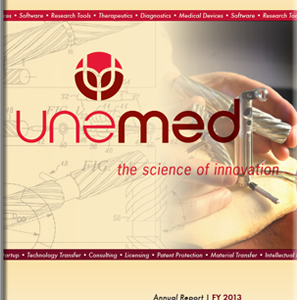by Agnes Lenagh, UNeMed | Dec. 18, 2012
 Contrary to popular belief, publishing your research will not guarantee that someone will notice your discovery and continue developing it into a tangible product that will reach the end user. As I previously mentioned, technologies first need to be developed and that is achieved through collaborations with industrial partners. For example, once a lead compound is identified it must go through a drug development process that includes pre-clinical research, development, and clinical trials. Additionally, drug development is focused on addressing the regulatory requirements of regulatory authorities, such as the FDA and later on for marketing approval. Overall, the process can be quite expensive and may exceed $100 million dollars per drug compound.
Contrary to popular belief, publishing your research will not guarantee that someone will notice your discovery and continue developing it into a tangible product that will reach the end user. As I previously mentioned, technologies first need to be developed and that is achieved through collaborations with industrial partners. For example, once a lead compound is identified it must go through a drug development process that includes pre-clinical research, development, and clinical trials. Additionally, drug development is focused on addressing the regulatory requirements of regulatory authorities, such as the FDA and later on for marketing approval. Overall, the process can be quite expensive and may exceed $100 million dollars per drug compound.
How Does Technology Transfer Occur?
 Technology is typically transferred through a license agreement in which the university retains ownership of the intellectual property, while the industrial partner obtains conditional rights to use and develop a technology. Before the technology transfer can take place, inventors must define and disclose the nature of their invention to the institution’s technology transfer office. New inventions are evaluated by technology licensing experts, who determine the intellectual property position and potential market for the technology. The technology transfer office will not be able to proceed with the invention if there is no intellectual property available, no value to industry or appropriate competitiveness in the market. On the other hand, inventions with an appropriate intellectual property and market position are given the green light and intellectual property rights are pursued. An invention management and commercialization strategy can begin once the intellectual property rights are established.
Technology is typically transferred through a license agreement in which the university retains ownership of the intellectual property, while the industrial partner obtains conditional rights to use and develop a technology. Before the technology transfer can take place, inventors must define and disclose the nature of their invention to the institution’s technology transfer office. New inventions are evaluated by technology licensing experts, who determine the intellectual property position and potential market for the technology. The technology transfer office will not be able to proceed with the invention if there is no intellectual property available, no value to industry or appropriate competitiveness in the market. On the other hand, inventions with an appropriate intellectual property and market position are given the green light and intellectual property rights are pursued. An invention management and commercialization strategy can begin once the intellectual property rights are established.
Technology transfer requires a proactive approach that combines engaging researchers, promoting the technology, and encouraging potential industrial partners to use the technology.
 The end goal of the commercialization strategy is to establish a commercial relationship with another party (e.g., employment, a sale or license), and negotiating a contract (e.g., compensation). A license is a contract between a licensor (e.g., the holder of a patent) and a licensee (e.g., an industry partner) that includes a number of conditions that the third party must satisfy. The licensee may be an established company or a new business start-up (that may be founded by the researcher).
The end goal of the commercialization strategy is to establish a commercial relationship with another party (e.g., employment, a sale or license), and negotiating a contract (e.g., compensation). A license is a contract between a licensor (e.g., the holder of a patent) and a licensee (e.g., an industry partner) that includes a number of conditions that the third party must satisfy. The licensee may be an established company or a new business start-up (that may be founded by the researcher).
The technology transfer office may grant nonexclusive, partially exclusive, or exclusive licenses. Multiple nonexclusive licenses may be granted to several companies to offer better opportunities to broaden the use of an invention across different fields. As mentioned above, the industry partner must satisfy a number of conditions which may include creating a satisfactory development or marketing plan, supplying information about the company’s ability to implement the plan, develop and commercialize the invention within a specified period of time, and making financial payments to the university. These payments are distributed to the inventors and shared within the institution to provide support for additional research, education, and participation in technology transfer activities.
Why is Technology Transfer important?
Technology transfer helps develop early stage intellectual property into tools for direct use by the research community, or into bases for new platforms, products, or services to be made into products for public use. Successful collaborations are formed between researchers across different universities or industries in order to advance the knowledge in a particular field or to further develop a technology. These collaborations may result in licensing or sponsored research opportunities that benefit both partners. In addition, technology transfer ensures that the interests and rights of the university in the intellectual property are protected. The university is able to retain the intellectual property rights of the technology and issue a license for the conditional use of the technology.
 Successful transfer and development of the technology helps promote the research institution and its commercial partners. The university obtains recognition and increases its reputation for their research and innovation potential. Industry partners can also reduce the costs incurred during their research and development stage by licensing technology from a university. Another benefit for the university involves using the licensing revenue to support further research and education at the institution. Universities protect their investments in research by patenting new technologies, which gives them an opportunity to reach the stream of commerce. The university’s investments in the technology help stimulate local economic development. The ultimate beneficiary of technology transfer is the public, who benefits from both the products that reach the market and the jobs resulting from the development, manufacturing, and sale of products.
Successful transfer and development of the technology helps promote the research institution and its commercial partners. The university obtains recognition and increases its reputation for their research and innovation potential. Industry partners can also reduce the costs incurred during their research and development stage by licensing technology from a university. Another benefit for the university involves using the licensing revenue to support further research and education at the institution. Universities protect their investments in research by patenting new technologies, which gives them an opportunity to reach the stream of commerce. The university’s investments in the technology help stimulate local economic development. The ultimate beneficiary of technology transfer is the public, who benefits from both the products that reach the market and the jobs resulting from the development, manufacturing, and sale of products.
I hope that this overview helped illustrate the field of research commercialization. Technology transfer works to complement academic research by pushing innovations out the lab door and into the hands of industry partners who will develop them into products for the benefit of the general public. Remember, if you have a research discovery that helps solve a significant problem, if the idea is innovative and unpublished, or if you believe you have discovered something unique with commercial potential or research value, don’t hesitate to consult with your technology transfer office. Here at UNeMed, we are always eager to help the University of Nebraska Medical Center faculty, staff, and students with any possible inventions they may have.
Contact us via email to report a research tool, or to discuss possible inventions. If you have any questions or comments, please do not hesitate to contact the authors or leave a comment below.For more information, you may also refer to our Inventor’s Handbook.


















thanks i need this information
This post is very perfect and have useful information post. Thanks for sharing this post.
[…] The Importance of Technology Transfer Contrary to popular belief, publishing your research will not guarantee that…tr […]